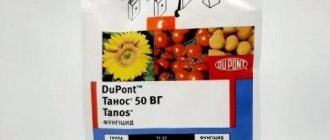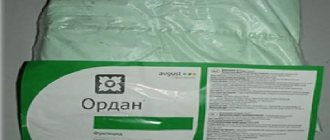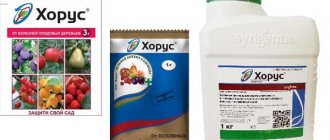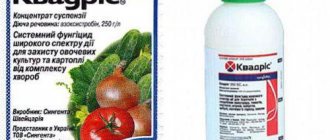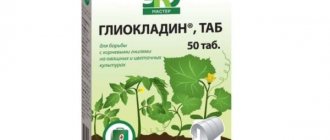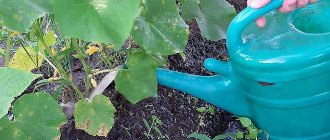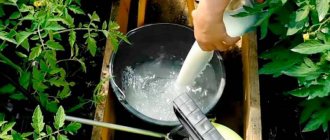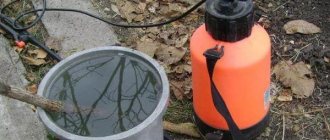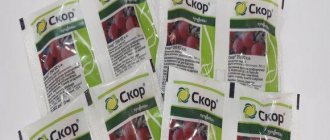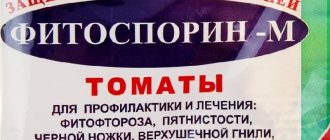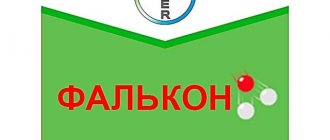Description and properties of Topaz fungicide
This is a hazard class 3 drug; it belongs to systemic drugs from the triazole group.
The chemical Topaz disrupts the process of sterol synthesis in pathogenic fungi, as a result of which they die.
Topaz can also be used for preventive purposes - after treatment, the drug penetrates into plant cells and prevents the development of fungus that gets inside.
On a note!
The active ingredient in Topaz is penconazole at a dosage of 100 g/l (or 10% of the total composition of the drug).
Photo of the drug Topaz
This chemical only affects pathogens and is not suitable for pest control because it is not an insecticide or acaricide.
Topaz effectively protects plants and fights the following diseases:
- powdery mildew;
- rust on foliage;
- gray mold;
- purple spotting;
- oidium;
- coccomycosis.
Fungicide Topaz - video
Topaz fungicide can be used to treat most garden, vegetable and ornamental crops, including it is suitable for:
- cucumbers;
- gooseberries;
- currants;
- rose bushes;
- cherries;
- peach;
- vineyard;
- indoor flowers.
But pathogenic fungi are resistant, so it is necessary to alternate treating plants with Topaz together or alternately with other fungicidal drugs.
Characteristics of the drug
Topaz EC is a highly effective systemic fungicide of the triazole class, the distinctive feature of which is the ability to disrupt the vital activity of fungal spores. The main active ingredient of the drug is penconazole at a concentration of 100 g/l.
The product is widely used to protect stone fruit, berry and pome crops, as well as ornamental plants from the following diseases:
- powdery mildew;
- rust;
- oidium;
- purple and brown spots;
- gray rot;
- Alternaria blight;
- ascochyta blight
The fungicide is completely absorbed by plant tissues within 3-4 hours after treatment and spreads through their vessels, preventing the transport of the growth tube of fungal spores into the leaf tissue and contributing to the death of pathogens. If the instructions for use are strictly followed, Topaz CE does not harm crops and does not have a phytotoxic effect.
Treat indoor plants and vegetable crops with fungicide.
Temperature changes do not affect the effectiveness of the drug, so treatments can be carried out at any time of the year except winter: during this period, fungi are in suspended animation, so spraying will not cause them any harm. Topaz is produced in the form of a concentrated emulsion , packaged in 2 ml ampoules or liter containers. The fungicide is produced by Syngenta.
Release form and composition
The main active ingredient in the Topaz fungicide is penconazole.
. It contains N and Cl atoms.
The principle of action of the drug is based on the penetration of the substance solution into the foliage cells and inhibition of the fungus.
Important!
Fungicide Topaz does not form a protective film on the surface of the foliage, like most other drugs.
Therefore, Topaz treatments can be carried out in any weather and in any climatic conditions - rain will not wash away the fungicide solution from the foliage, and penconazole continues to fight pathogens during sudden cold snaps or heat.
Fungicide Topaz is a liquid concentrate that is highly soluble in water. Release form:
1 liter container or 2 ml ampoules.
Description of the drug, what it is, release form, toxicity
The product contains a potent substance - penconazole, which is mainly used for powdery mildew. The package contains a substance concentration of 100 grams per liter.
The drug works as follows:
- Penconazole blocks the spread of fungus and prevents the growth of spores. Even with a small concentration, the pathogenic fungus dies and stops reproducing. The effectiveness of the drug is that it is immediately absorbed into the plant, so no weather conditions or temperature changes affect it.
- The only drawback is the storage limitation. The shelf life is no more than 4 years. You should not use an expired product, since low-quality chemicals make the fruits inedible and poisonous and can cause irreversible damage to the plant.
- The chemical is sold in sachets with a dosage of 3 milligrams, or ampoules with a dosage of 2 milligrams. If you need to treat a large area, then Topaz can be bought in a 1-liter plastic bottle and diluted in accordance with the instructions.
The active substance is toxic
Although the drug is less dangerous for humans than for animals or insects, it is important to take precautions when using it and keep the substance away from children
Mechanism of action
After treating the vegetative mass of plants, Topaz does not linger on its surface, but immediately penetrates inside. The active substance included in the drug suppresses fungal spores, both beginning to form and germinating, and prevents their further development.
Penconazole, together with the juice, moves through the vessels of the plants, enters the growing shoots and new growth, protecting them from the penetration of pathogenic fungi and their spores.
This active substance stops the biosynthesis process in fungal spores, as a result they and the fungus itself stop growing and do not develop further. And in a short time the affected plants are cured and grow stronger.
Topaz: Plant Treatment - video
Composition and action
The active ingredient of the Topaz fungicide is the synthetic triazole penconazole (formula in the figure) at a concentration of 10% (100 g/l). Some popular sources attribute the “unnaturalness” of its DV to Topaz’s shortcomings. Indeed, there are no analogues of penconazole in living nature. But most of the poisons, drugs, chemicals for torture and other rubbish are isolated from herbs and trees - it couldn’t be more natural. Everything is poison and everything is medicine, you just need to know what it is and how to handle it.
The formula of penconazole shows that during its breakdown, substances that can have a long-term effect on the environment cannot, in principle, be formed. Nitrogen, given the insignificant dosages of the drug, can be ignored, and the chemically very active chlorine will instantly find “partners” for the formation of harmless stable compounds.
The effect of penconazole on pathogens is specific: it targets germinating spores with sniper precision. If, say, Ordan is called a “semi-systemic” pesticide (it penetrates plants, but does not spread throughout them), then Topaz is a “supersystemic” pesticide. In plants, it is concentrated in young tissues immediately after the growth point, and follows it as the protected object develops. But in this same, most vulnerable zone, spores of powdery mildew and physiologically similar fungi germinate. Using military terminology, Topaz calculates the enemy landing site, sets up an ambush there and destroys the enemy, preventing him from deploying battle formations. Which, as you know, is the key to the complete success of the operation.
Hazard class and precautions
The drug is classified in the third hazard class (low danger). However, Topaz has a negative effect on human skin and mucous membranes, so work with the drug should be done in protective clothing and gloves, and also protect the eyes and respiratory tract.
Experts note that Topaz is of little danger to pollinating insects, so a solution of this drug can be used to treat garden and vegetable crops during the flowering period, while observing the rules for diluting the fungicide.
Precautionary measures
Fungicide Topaz is a substance of hazard class 3, toxic to fish. The drug is not dangerous for birds and insects. When working with the substance, observe safety precautions.
While applying the Topaz fungicide, smoking, eating or drinking is prohibited. Work is carried out on a dry, cloudy day or in the evening. Allowable wind speed is up to 5 m/s.
When working with the solution, it is important to protect the skin and respiratory system. It is better to use a respirator and protective suit. People who do not have protective equipment and animals should be kept at a distance of more than 150 m from the treatment site.
Advice! If Topaz comes into contact with the skin, wash the contact area thoroughly with water.
When administering Topaz fungicide, you must drink 2 glasses of water and 3 tablets of activated carbon and induce vomiting. You definitely need to see a doctor.
Advantages and disadvantages
Experts include the main positive qualities of the Topaz fungicide:
- The period of protection of plants with the drug is up to 2 weeks, so during the summer season, if necessary, it is enough to carry out no more than 3 treatments. As a result, the load of chemicals on plants and soil will be lower. Than when using other fungicidal agents;
- the fungicide can be used for preventive treatments, as well as for treating plants at different stages of development of fungal diseases;
- the product is quite economical;
- the drug effectively affects the fungus and its spores;
- the price of the product is low, therefore it is suitable for all categories of farmers;
- it is possible to use Topaz in tank mixtures with a number of other drugs;
- Can be used in any weather, as the drug is not washed off by rain;
- when properly diluted, Topaz solution is not dangerous to people;
- It is possible to carry out treatments with Topaz solution at all stages of plant development.
Fungicides:
Preparation Switch Pure Flower Preparation Quadris
The disadvantages of Topaz include:
- the solution of this fungicide is toxic to the inhabitants of water bodies, so it is used with caution near rivers, lakes or ponds;
- the fungus is resistant to Topaz, as well as to most other fungicides, so during the summer season it is necessary to change drugs in the process of combating fungal diseases;
- penconazole, which is part of the drug, is quite toxic in large quantities and has the ability to accumulate in the soil, so it is recommended to use Topaz in garden plots once every few years;
- When working with the drug, you must take precautions, dilute the product strictly in accordance with the instructions, as well as safety precautions.
Advantages of using Topaz in a summer cottage
As you have seen, Topaz is a fungicide with a very wide range of applications. Even though many analogues of Topaz can be found on the market today, the choice should be given to this drug, since it has a number of advantages:
- “Topaz” is precisely the chemical that has a long period of influence on the spores of fungal diseases. Thanks to this, preventive spraying can be done only twice during the month, reducing the pesticide load on plants and soil.
- Instant absorption of the drug by plants makes it possible to stop the growth of fungal spores within 2-3 hours after treatment.
- The rate of use of the drug is very low, so one sachet is enough for almost the entire season, even if its use is necessary both in the garden and in the vegetable garden.
- "Topaz", unlike other drugs, can be used for a very large number of plants.
- “Topaz” is used at almost all stages of the plant growing season: from the beginning of growth to the beginning of fruit formation. Even if it comes into contact with ripe fruits, the toxic effect of the drug remains minimal, which allows them to be eaten without fear of poisoning.
- “Topaz” is compatible with many other drugs, which allows it to be used for complex plant treatments.
Preparation of working solution
Topaz working solution is prepared as follows:
- First, the required amount of the drug is mixed in a small amount of water. It is necessary to stir the resulting liquid for several minutes so that all of the liquid Topaz concentrate dissolves;
- then the rest of the liquid is added and stirring is done again;
- then the drug is poured into a sprayer and the plants are treated.
The prepared working fluid should be used in the first hours; the prepared solution cannot be stored. During treatment, the solution should be shaken periodically.
Important!
After completion of work, the remaining working solution of the Topaz drug is disposed of.
It is better to treat plants with Topaz solution in dry, windless weather from May to September. The interval between crop treatments should be observed, taking into account the type of plants, the degree of their damage, as well as the type of pathogens.
The maximum dosage is used when there is a high degree of disease damage; for preventive spraying, the dosage of the drug is much lower.
Topaz is more effective as a prophylactic or in the fight against fungal diseases in the early stages. If the disease is severely advanced, it is better to use stronger fungicides.
How to apply fungicide correctly
The instructions for using the product are completely simple, since Topaz is a moderately toxic substance and working with it takes place without any consequences or poisoning. The main thing is to follow all recommended proportions and precautions.
For the treatment of plants, the drug Topaz is available in glass ampoules. The solution of one ampoule is pre-diluted in a small amount of water, mixed well and topped up with ten liters of liquid. A special spray bottle is suitable for spraying.
For medicinal purposes, shrub crops are processed in calm, dry weather. It is better that there is no precipitation on the day of spraying. The prepared solution must be used within 24 hours, as it is not stored. Such events are held twice a year. In early spring before flowering and immediately after it.
Vegetable and flower plantings are sprayed with fungicide only when a disease occurs. At the first signs of illness, the necessary treatment is carried out. All affected foliage must be removed, otherwise Topaz will not give positive results.
Every year, for preventive purposes, without waiting for powdery plaque, black currants and gooseberries should be sprayed with Topaz, the first time when buds just appear on the bushes. The second treatment is carried out after the final harvest, in cloudy, not too sunny weather.
Topaz for grapes
Every year the grapevine is subject to a disease such as powdery mildew. An excellent means of combating oidium is the Topaz fungicide; it is excellent for grapes, and the attached instructions for use inform exactly when to spray and in what doses to dilute the chemical.
Each Topaz ampoule consists of two milliliters of the composition. To process grapes, you will need two ampoules, which are diluted in a bucket of water. The consumption of working fluid is up to one and a half liters per ten square meters.
The first treatment of grape bushes is carried out immediately after bud break. Second, after flowering. Activities should be carried out every three weeks. Two weeks before harvest, spraying stops. It is very important not to exceed the prescribed dosage, since a supersaturated solution can destroy the crop.
Grapes affected by powdery mildew
If it was not possible to use all the solution, the remainder should be poured out, since it is not suitable for the next treatment. All effective components of the drug work only within 24 hours after preparing the liquid.
Topaz: instructions for use
Berry and fruit crops should be treated with Topaz for preventive purposes, as well as at different stages of fungal diseases.
Vegetable crops, ornamental garden and indoor plants are sprayed with a solution of this fungicide from the moment the first symptoms of the disease appear.
Consumption rates for Topaz for various crops
Fungicide Topaz: instructions for use. On what crops is it used - video
Topaz for apple, pear, apricot, peach, cherry and other fruit trees
Fruit trees are treated with Topaz against powdery mildew or fruit rot - this drug is most effective against these fungal diseases. These diseases cause the greatest damage to trees in orchards. The fungus quickly spreads throughout the area, and if treatment is delayed, it can lead to the death of part or all of the crop.
The following garden crops need to be processed:
- cherries;
- pears;
- apple trees;
- peach.
Young crops use 2 liters of working fluid, adults use up to 5 liters. The working fluid should be prepared as follows:
dissolve 2 ml of the product in a bucket of water.
For preventive purposes, fruit trees are treated during budding or at the beginning of flowering. In total, no more than 4 sprayings can be carried out during the season with an interval between them of 12-14 days.
Topaz for grapes
The main disease that affects grape plantations and can cause severe damage to grape vines is oidium. The main signs of this disease are the appearance of swollen yellow-brown spots on the foliage. Subsequently, the leaves become deformed and fall off prematurely.
For preventive purposes, a couple of treatments are carried out with Topaz solution after the buds open, as well as after the grapes have flowered.
To prepare the working fluid, dissolve 2 ml of fungicide in 10 liters of water. For 10 sq. m. area consume up to 2 liters of solution.
Topaz for currants, raspberries, gooseberries and other berry bushes
All berry bushes should be treated with Topaz solution against powdery mildew.
This drug most effectively protects against this disease during preventive treatment at the beginning of flowering of such shrubs as:
- raspberries;
- currant;
- gooseberry.
Topaz for processing currants - video
It should also be applied at the first sign of powdery mildew on these perennials.
To prepare the working fluid, 1 ml of the drug should be dissolved in 5 liters of water. Each bush requires 1.5 liters of solution. If the berry bush is too large, then it requires 2 liters of working fluid.
Pests in the garden!
Leaf Roller _
For vegetable crops
This fungicide is used to treat cucumbers in open ground or in greenhouses against powdery mildew.
2 ml of fungicide is diluted in 10 liters of liquid, and cucumber crops are treated with this working solution.
In greenhouses, to treat 1 m2 of area, no more than 300 ml is required, and in open ground beds, 100 ml of working fluid is consumed for the same area.
Topaz is the best remedy for powdery mildew - video
Usually, a single spraying of cucumbers with Topaz against powdery mildew is sufficient. If the symptoms of the disease do not go away, then re-treatment with Topaz is carried out a couple of weeks after the first.
Fungicide Topaz for rose bushes
Roses, like other flowers in flower beds, often suffer from fungal diseases. To save the “queen of flowers,” Topaz is often used along with other fungicides. It should be used at the first signs of the disease.
The working solution is prepared as follows:
4 ml of Topaz is dissolved in 10 liters of water.
The resulting liquid is sprayed over the foliage of the bush. In total, no more than three treatments of roses with Topaz can be carried out during the season with an interval of 2.5-3 weeks.
Topaz for garden flowers
Flowers in flower beds suffer most from rust and powdery mildew.
The following plants in the flower garden are most often affected by them:
- violets;
- chrysanthemums;
- peonies;
- irises;
- clematis;
- carnation;
- Snapdragon.
Application procedure
The use of Topaz fungicide does not present any difficulties: the ampoule is broken open, poured into a filled sprayer tank, closed, the device is shaken and the work begins. If Topaz is used from a bottle for repeated sampling of the drug, there is no need to remove the standard cap. It is enough to remove the protective cap, pierce the stopper with the needle of a medical syringe, draw out as much as you need, and put the cap back; this will ensure better preservation of the drug throughout the shelf life. For the purposes of indoor floriculture, it is better to immediately draw the entire Topaz ampoule into a syringe and store the remainder in the refrigerator, covering the needle with its standard cap.
Instructions for using the Topaz fungicide are given in the table:
Spraying is carried out according to the usual rules: in the morning (better) or in the evening in calm, warm weather; preferably cloudy. Preventive treatments of young, but already fully formed plants will be more effective, because Almost all of the topaz will remain in the growth zones that existed at the time of its application, and almost all of it will not move into the newly formed ones. If the plant bushes heavily/spreads lashes (for example, cucumbers), then in the period before flowering it is necessary to carry out a second preventive treatment 10-15 days after the initial one.
Duration and place of storage
An unopened drug can be stored for 4 years from the date of manufacture. However, it is advisable to use this product during the first couple of years, since with longer storage the amount of toxic penconazole in the concentrated solution increases.
At the end of the storage period, the fungicide should be discarded.
Topaz 3ml fungicide - video
Important!
It is strictly prohibited to use expired Topaz for processing, since the level of toxic substances in it is too high.
This toxic product should be stored separately from food, pet food and medications and out of the reach of children.
What products can the fungicide Topaz be combined with?
- Kinmiks
- Kuprosat
- Topsin-M
- Horus
Without exception, all chemicals require careful and careful handling. Fungicide Topaz is no exception:
- The container used is used ONLY FOR SOLUTION
- The fumes are toxic. Respirator protection is required.
- If the product gets on your skin, rinse with plenty of water.
- For minor pore poisoning, you need to take activated carbon with 0.5 liters of water.
- In case of food poisoning - urgent gastric lavage
- It is strictly forbidden to drink, smoke or eat food when working with the chemical.
- Topaz containers (ampoules) cannot be disposed of with regular waste. They should be burned or buried away from water sources.
The storage location for Topaz fungicide should be dark, isolated, away from food, medications and, of course, children.
Topaz is popular due to its effectiveness and reasonable price. Using Topaz, strictly following the instructions, will help preserve the harvest and not cause harm to the environment.
Compatibility of the drug Topaz with other drugs
Topaz fungicide is compatible with other similar chemicals with an alkaline reaction, in particular it can be used in tank mixtures with:
- Kinmiks;
- Horus;
- Cuproxat.
However, before preparing the tank mixture, the compatibility of the drugs should be checked. To do this, small doses of fungicides are mixed in a container and watched to see if a chemical reaction occurs between them. If no precipitate forms, no heat is generated, or no bubbles appear in the liquid, then the substances taken are compatible with each other.
Important!
It is strictly forbidden to use Topaz simultaneously with drugs that have an acid reaction. At least 10-12 days should pass between treating plants with Topaz and such preparations.
Photo of the consumption rate of the drug Topaz
Description of the variety
The Topaz apple tree appeared as a result of crossing Rubin and Vanda, which are quite famous and loved by many gardeners. Jaroslav Tupi, who was an employee of the Institute of Experimental Botany of the Academy of Sciences in the Czech Republic, worked on its creation. In 1984, Topaz was first introduced not only to amateurs, but also to professionals. In Europe, this variety has gained wide popularity: juices are squeezed from its fruits and excellent purees are made.
The description of this variety indicates that the tree grows of medium size, with a dense and spreading crown. The crown can be round in shape or in the form of a pyramid, expanding at the top. It requires mandatory shaping and sanitary pruning, and is prone to overgrowing. The branches are directed downwards.
The foliage in the lower part has strong pubescence and is painted in a rich emerald color. The shape of Topaz leaves is oblong, with a rounded base. The flowers are saucer-shaped, medium in size, and snow-white in color.
Apples most often form on ringlets. In the southern climate, fruits are also formed on last year's growths. The weight of one apple reaches 200 grams, its shape is round, slightly flattened. At the stage of technical ripeness, the main color of the fruit is greenish-cream, and the outer color has bright red-orange spots, which occupy almost half the area of the entire apple.
See also
Description of the Persian apple tree variety, yield characteristics and growing regionsRead
The pulp of the Topaz apple tree has a pleasant sweet and sour taste and is quite spicy. The aroma is tart and strong. The skin on apples is medium hard, a little rough to the touch, a little oily. The fruits have a universal purpose and can be eaten both fresh and used for making jam, compote, and soaking.
Tasters note that they are characterized by excellent dessert taste, rated at 4.8 points.
The drug Topaz: reviews of use
Ira, 54 years old, Leningrad region: Powdery mildew regularly appears on plants in my garden plot. I used different means, but the fungus quickly gets used to them and no longer dies. I saved my garden only with Topaz - I carried out a couple of treatments, and the powdery mildew disappeared. I can say that Oksikhom also turned out to be quite effective, but Topaz is cheaper and less toxic.
Elena, 46 years old, Tambov region: I am engaged in growing cucumbers in greenhouses and in garden beds for sale. And since the second half of summer, my cucumber beds have been affected by powdery mildew for many seasons, despite following all the rules of care. The season before last, a neighbor in a dacha cooperative advised using Topaz to combat this fungal disease. As soon as I noticed the appearance of the disease, I carried out the first spraying, and a couple of weeks later - the second. And the powdery mildew disappeared. Now I will do this regularly - treat cucumbers with Topaz when this disease appears.
The fungicidal drug Topaz is one of the best preventive and therapeutic agents against a number of fungal diseases on garden, vegetable and ornamental plants.
It is easy to dilute and easy to use, but fungi quickly get used to this product, so after a couple of treatments the drug has to be replaced with other fungicides that are also effective against these pathogens.
additional characteristics
Advantages and disadvantages
Pros:
- Excellent dessert taste of fruits;
- Good transportability;
- Apples are stored for a very long time;
- Because of their composition, apples are recommended for metabolic disorders and are used in dietary nutrition;
- The variety is resistant to scab and moderately resistant to powdery mildew.
Cons: If apple trees grow in a cool climate, the apples will become sour.
Dimensions of an adult tree, annual growth
The tree grows medium-sized and has a height of 2.5–3.5 m.
Young apple trees grow very intensively, while older ones grow moderately.
Productivity and frequency of fruiting
Young trees bear fruit every year , while older trees produce fewer apples or bear fruit every other year.
Tasting assessment
Apples have excellent dessert taste. We have not found any information on the exact number.
The fruits of the Topaz apple tree have a dessert taste.
Winter hardiness and disease resistance
The trees have excellent winter hardiness.
Important! If they are planted in places with high humidity or in lowlands, then young apple trees may freeze.
The variety has excellent immunity to scab and average resistance to powdery mildew.
Features of ripening and fruiting
The winter apple variety Topaz will produce its first harvest only when the tree reaches six years of age. The apple tree blooms at the end of May. The description of the variety suggests that this species belongs to the winter variety, therefore the harvest is carried out closer to the end of September or the beginning of October. In any case, they do this a week earlier than the famous Golden Delicious variety.
After picking apples and storing them, they ripen in November, and the fruits are able to retain their marketability and taste for six months. If the recommended storage conditions are observed, the harvest can be preserved for longer than the specified period.
Use of Topaz for rust
Another dangerous plant disease caused by Phragmidium or Puccinia fungi is rust. When infected, brown tubercles with pustules of varying sizes form on the leaves of garden crops. When they crack, a “rusty” colored powder spills out. Very quickly the spots form stripes and the leaves fall off. Depending on the culture affected, several types of rust are divided: brown wheat, gooseberry goblet, oat crown, linear cereal, pine blister rust and others. Any of these types are dangerous. Therefore, you need to monitor your plants and, at the first sign of rust, take measures to get rid of it.
Insects are considered carriers of the disease; fungal spores can be carried by the wind. In infected plants, the process of photosynthesis is reduced, metabolism is disrupted, and shoot growth slows down and stops. How to cope with the disease?
Fungicides will help cope with the disease. The drug Topaz is used for treating seeds of sugar beets, flax, and sunflowers. Immediately after the leaves bloom, they are treated with this product. It is recommended to repeat the treatment twice after 14 days. Effectively applied to coniferous trees, currant bushes, gooseberries, and fruit trees.
You may be interested in: Fertika fertilizer - assistant to gardeners
Plants affected by rust are immediately removed and then sprayed with Topaz. Double treatment is required every 10 days.
